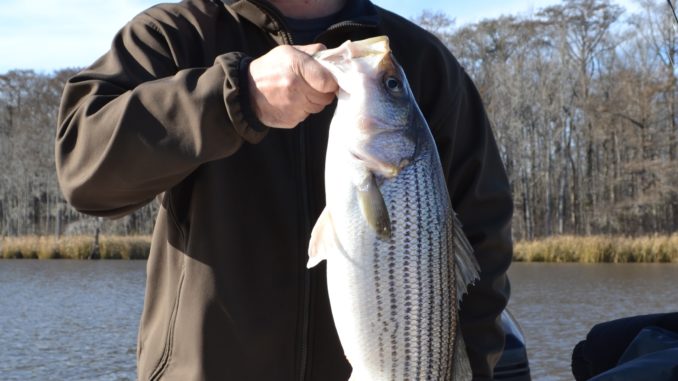
Artificial lures are the ticket for winter stripers in the lower Roanoke River.
So you filled your 2014 deer tags and don’t know what to do with yourself until spring peepers start chirping and turkey gobblers strut their stuff.
You might consider winter striped bass — lots of striped bass — and not at places you’d normally think about finding these fish that have the feeding instincts of piranhas and bulldog attitudes when hooked.
Few fishing venues will rock and roll with winter fishing for stripers, aka rockfish, as much as the swamps, creeks, guts and oxbows off that section of the Roanoke River near the Martin County town of Jamesville. But if you don’t know the river that well, it can be easy to get “turned around,” especially if you end up chasing rockfish into an oxbow or creek. These wild spots look virtually the same — lots of tall cypress trees and hundreds of cypress knees along identical shorelines. Davy Crockett could get lost after a couple of turns in a swamp off the river while chasing a hot striper bite.
Maybe carry a pocket GPS?
Rockfish cluster during the winter around feeder creeks near Jamesville and downstream around Plymouth, and around Rice and Louise islands close to where the river dumps into the Albemarle Sound. The reason? Mainly, those areas have plenty of backwater swamps that hold tons of baitfish, and striped bass, like most of us, prefer to eat when we’re hungry.
The baitfish — mostly blueback herring and alewives — often get corralled in shallow areas such as the streams that feed the river just west of the sound, and that makes for less effort required by stripers to chase down a meal. Albemarle Sound also holds plenty of bait, but if you were a rockfish looking for an easy meal, would you rather try for a herring in the huge sound or sit in ambush, waiting for one to swim by in a shallow creek that’s maybe 30 feet wide?
Fishermen on the lower end of the Roanoke also carefully watch the weather for big rain events that will send water spilling down from the upper end of the river and the big upstream reservoirs: John H. Kerr, Gaston and Roanoke Rapids lakes. When a heavy rain sends a push of freshwater downstream, and the extra flow gets to the river’s mouth, it spreads across a large delta. At some point, the waters flow out of the swamps and creeks and back into the river and the sound, and that’s when striper fishing gets really interesting.
Richard Andrews of Tar-Pam Guide Service in Bath pretty much has the winter striper patterns nailed down.
“When the water is released from (Kerr) and goes through Gaston then Roanoke Rapids, that slug goes downstream and raises the level back in the flood plain,” he said. “When the blackwater comes out of the flood plain, it comes out of the trees. “That’s when stripers will stack up waiting for the herring to come out.”
Andrews said in the winter water, which is normally clear, it’s easy to detect when swamp water is being pulled out of the trees and into feeder streams.
“You can see plumes of blackwater coming out of the trees,” he said. “Those spots also aren’t too bad of a place to throw a lure.”
Andrews, who also fishes each spring for spawning stripers in the upper Roanoke near Weldon, said he’s learned to watch the flood-stage indicator at Hamilton, which is upstream from Williamston, to know when a surge of water will reach the low-lying swamps.
It takes about 1 1/2 days for a big slug of water to reach Jamesville, Andrews said.
The low-lying swamps along the river are visually-stunning venues during winter, which makes a trip there as appealing for some outdoorsmen as the prospect of landing fish. The edges of feeder streams are marked by large cypress trees waving strands of Spanish moss and thousands of cypress “knees” and the edges of swamps. But if you’re a hard-core rockfish hound, the good news is the region is neither fished nor hunted hard.
Andrews, who has little personal interest in live- or dead-bait fishing, even with novice clients, said the lower portion of the river and its tributaries suit him well, especially during winter.
“I like to get people on the boat who want to learn how to fish,” he said. “You really can’t use live or cut bait; there’s too much stuff on the bottom and too many hangups.
“But there’s also something exciting about casting a lure and getting a fish to attack it. You set the hook yourself, fight him, get him to boat, admire him, maybe take a picture and release him.”
If that sounds eerily similar to catch-and-release fishing for largemouth bass, you’re correct. That’s exactly what winter striper fishing is like on the lower Roanoke.
The keeper season runs March 1-April 30, with anglers limited to two fish at least 18 inches length but none in a 22- to 27-inch slot limit, and just one fish longer than 27 inches, so winter striper fishing is just for fun.
Happily, because of a dearth of natural food during most winters, stripers are much more likely to slam a soft-plastic Fluke lure or a big Zara Spook than during spring and summer when the water is full of baitfish.
“You can vary your lures, too, just like for bass fishing, from hard baits to soft baits,” said Andrews, who said one of his favorite soft-plastic baits is a 4- or 5-inch Zoom Fluke in white, yellow or pink, fished on a 3/8-ounce leadhead jig. Andrews also soaks his lures with Pro Cure gel, a fish scent, in mullet flavor. with the lure covered by Pro-Cure Mullet Super Gel fish scent.
“It’s good for 20 to 30 casts,” Andrews said. “It works for me; I think it increases bites. I believe they like the smell, and they can sense it from a long ways.”
A basic bass-fishing rig — 7-foot medium-action rod fitted with a smooth baitcaster or spinning reel — will work for stripers. But instead of monofilament main line, Andrews prefers 10-pound Sufix braid.
“You’re going to be throwing lures at a mostly marine environment/habitat, so you’ll have the chance to hit sharp stuff, such as barnacles and even edges of metal stuff in the water,” he said. “Braid will save you a lot of cut-offs and besides that, it’s strong and can handle a striper’s runs. You can even turn his head if you think he’s going to wrap you up in a tree root or something.
“But the main thing I like about braid is you can throw it longer. Plus, if you’re jig fishing, it’s got a lot more sensitivity. If you’re jigging soft plastics in deep water, braid lets you feel every little tick and bump.”
Andrews likes to tie in a 2-foot section of 17-pound fluorocarbon leader between the braid and the jighead.
“Fluorocarbon adds a little more (give) than most people think,” Andrews said. “Most people around Washington and Bath use fluoro leaders for speckled trout and red drum because you’re basically fishing the same spots you’d find stripers.”
One of the attractive aspects of winter striped bass fishing is fish often will “school” or sit along a stretch of creek where water is flowing out of a swamp and pulling baitfish from the protection of tangled cypress roots.
“It’s not unusual to have 30- to 50-fish days,” Andrews said. “You can have a lot of action, and that’s just a lot of fun, especially for people who haven’t experienced that kind of bite before.”
Two of Andrews’ clients on one trip last winter, fit that category perfectly: Dan and Eric Korman of Wilmington. On a cold day more suited for duck hunting than fishing, the Kormans duo and Andrews hooked and landed nearly three dozen stripers from 12 to 20 inches long between Cow Creek and Devil’s Gut, the latter being a narrow creek that splits off the main river near the Astoria boat ramp, meanders northwest and rejoins the curvy Roanoke after several miles. Between the Gut and the river proper is a large section of the Roanoke River Wetlands Game Land.
“I like to target the points on Devil’s Gut,” Andrews said, “especially where any small stream empties out of the swamp into the larger creek. Baitfish are pulled out, and stripers will stick there, waiting on ’em.”
It took a while for the Kormans to get the hang of knowing when to set a hook when a striper “ticked” their plastic grubs, but they soon developed the skill.
“Typical for this time of year, you can catch a striper here, two there, three over there, and by the end of a day, you’ve got 30 or 40 fish,” Andrews said.
DESTINATION INFORMATION
HOW TO GET THERE/WHERE TO GO — To The N.C. Wildlife Resources Commission’s Astoria public boat ramp is north of Jamestown on Astoria Rd. Jamesville is most-easily accessed by US 64 east out of Raleigh, through Williamston. It provides excellent access to the Roanoke River and Albemarle Sound. The striper fishing picks up in the area after Thanksgiving and can be excellent through March before fish start to move upriver on their spring spawning run.
TACKLE/TECHNIQUES — Baitcasting or spinning outfits suitable for largemouth bass fishing are adequate for Roanoke River stripers during the winter. Spool reels with 10-pound braid, with about 24 inches of 10-pound fluorocarbon leader. Soft-plastic jerkbaits like Flukes are excellent rigged on 3/8-ounce jigheads. The most effective lures will be 4 to 5 inches long and will mimic blueback herring colors.
GUIDES/FISHING INFO — Richard Andrews, Tar-Pam Guide Service, 252-945-9715, www.tarpamguide.com. See also Guides & Charters in Classifieds.
ACCOMMODATIONS — Hampton Inn, Williamston, 855-271-3622; Econo Lodge Williamston, 800-997-5148.
MAPS — DeLorme’s North Carolina Atlas & Gazetteer, 800-561-5105, www.delorme.com.

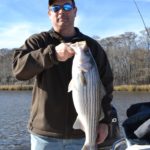
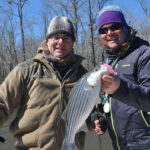
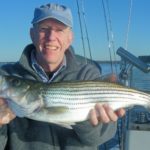
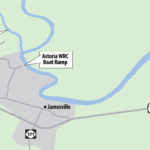


Be the first to comment